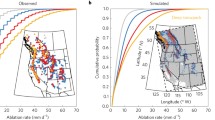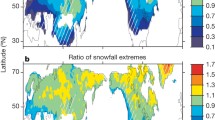Abstract
As the planet warms, mountain snowpack is expected to melt progressively earlier each spring. However, analysis of measurements in the western United States shows that the change in the date when snowpack disappears is not uniform: for 1 °C of warming, snowpack disappears 30 days earlier in some regions, whereas there is almost no change in others. Here we present an idealized physical model that simulates the timing of snowpack melt under changing temperature and use it to show that this observed disparity in the sensitivity of snowpack disappearance to warming results from a mechanism related to the sinusoidal shape of the annual cycle of temperature. Applying this model globally, we show that under uniform warming the timing of snowpack disappearance will change most rapidly in coastal regions, the Arctic, the western United States, Central Europe and South America, with much smaller changes in the northern interiors of North America and Eurasia.




Similar content being viewed by others
Data availability
SNOTEL data are available from the Natural Resources Conservation Service, https://www.wcc.nrcs.usda.gov/snow/. NARR output is available from the National Centers for Environmental Information, https://www.ncdc.noaa.gov/data-access/model-data/model-datasets/north-american-regional-reanalysis-narr. The global reanalysis data used here are available from the Global Modeling and Assimilation Office, https://gmao.gsfc.nasa.gov/reanalysis/MERRA-2/.
Code availability
Code for the VIC model is available at: https://vic.readthedocs.io/en/master/. Code used to run the VIC model, analyse model output and observations and generate the plots can be found at https://github.com/amatoevan/snowpack_zeta/.
References
Cayan, D. R., Kammerdiener, S. A., Dettinger, M. D., Caprio, J. M. & Peterson, D. H. Changes in the onset of spring in the western United States. Bull. Am. Meteorol. Soc. 82, 399–416 (2001).
Stewart, I. T., Cayan, D. R. & Dettinger, M. D. Changes toward earlier streamflow timing across western North America. J. Clim. 18, 1136–1155 (2005).
Mote, P. W. Climate-driven variability and trends in mountain snowpack in western North America. J. Clim. 19, 6209–6220 (2006).
Mote, P. W., Li, S., Lettenmaier, D. P., Xiao, M. & Engel, R. Dramatic declines in snowpack in the western US. NPJ Clim. Atmos. Sci. 1, 2 (2018).
Doesken, N. & Judson, A. The Snow Booklet: A Guide to the Science, Climatology, and Measurement of Snow in the United States (Colorado State Univ., 1996).
Lettenmaier, D. P. & Gan, T. Y. Hydrologic sensitivities of the Sacramento–San Joaquin River basin, California, to global warming. Water Resour. Res. 26, 69–86 (1990).
Hamlet, A. F., Mote, P. W., Clark, M. P. & Lettenmaier, D. P. Effects of temperature and precipitation variability on snowpack trends in the western United States. J. Clim. 18, 4545–4561 (2005).
Luce, C. H., Lopez-Burgos, V. & Holden, Z. Sensitivity of snowpack storage to precipitation and temperature using spatial and temporal analog models. Water Resour. Res. 50, 9447–9462 (2014).
Hamlet, A. F. & Lettenmaier, D. P. Effects of climate change on hydrology and water resources in the Columbia River basin. J. Am. Water Resour. Assoc. 35, 1597–1623 (1999).
Barnett, T. P., Adam, J. C. & Lettenmaier, D. P. Potential impacts of a warming climate on water availability in snow-dominated regions. Nature 438, 303–309 (2005).
Westerling, A. L., Hidalgo, H. G., Cayan, D. R. & Swetnam, T. W. Warming and earlier spring increase western US forest wildfire activity. Science 313, 940–943 (2006).
Gergel, D. R., Nijssen, B., Abatzoglou, J. T., Lettenmaier, D. P. & Stumbaugh, M. R. Effects of climate change on snowpack and fire potential in the western USA. Climatic Change 141, 287–299 (2017).
Zeng, X., Broxton, P. & Dawson, N. Snowpack change from 1982 to 2016 over conterminous United States. Geophys. Res. Lett. 45, 12940–12947 (2018).
Evan, A. T. A new method to characterize changes in the seasonal cycle of snowpack. J. Appl. Meteorol. Climatol. 58, 131–143 (2019).
Pierce, D. W. & Cayan, D. R. The uneven response of different snow measures to human-induced climate warming. J. Clim. 26, 4148–4167 (2013).
Mankin, J. S. & Diffenbaugh, N. S. Influence of temperature and precipitation variability on near-term snow trends. Clim. Dyn. 45, 1099–1116 (2015).
Serreze, M. C., Clark, M. P., Armstrong, R. L., McGinnis, D. A. & Pulwarty, R. S. Characteristics of the western United States snowpack from snowpack telemetry (SNOTEL) data. Water Resour. Res. 35, 2145–2160 (1999).
Mesinger, F. et al. North American regional reanalysis. Bull. Am. Meteorol. Soc. 87, 343–360 (2006).
Mote, P. W., Hamlet, A. F., Clark, M. P. & Lettenmaier, D. P. Declining mountain snowpack in western North America. Bull. Am. Meteorol. Soc. 86, 39–49 (2005).
Anderson, E. A. Development and testing of snow pack energy balance equations. Water Resour. Res. 4, 19–37 (1968).
Andreadis, K. M., Storck, P. & Lettenmaier, D. P. Modeling snow accumulation and ablation processes in forested environments. Water Resour. Res. 45, W05429 (2009).
Liang, X., Lettenmaier, D. P., Wood, E. F. & Burges, S. J. A simple hydrologically based model of land surface water and energy fluxes for general circulation models. J. Geophys. Res. Atmos. 99, 14415–14428 (1994).
Hamman, J. J., Nijssen, B., Bohn, T. J., Gergel, D. R. & Mao, Y. The Variable Infiltration Capacity model version 5 (VIC-5): infrastructure improvements for new applications and reproducibility. Geosci. Model Dev. 11, 3481–3496 (2018).
Gelaro, R. et al. The Modern-Era Retrospective Analysis for Research and Applications, version 2 (MERRA-2). J. Clim. 30, 5419–5454 (2017).
Trujillo, E. & Molotch, N. P. Snowpack regimes of the western United States. Water Resour. Res. 50, 5611–5623 (2014).
Holland, M. M. & Bitz, C. M. Polar amplification of climate change in coupled models. Clim. Dyn. 21, 221–232 (2003).
Collins, M. et al. in Climate Change 2013: The Physical Science Basis (eds Stocker, T. F. et al.) Ch. 12 (IPCC, Cambridge Univ. Press, 2013).
Musselman, K. N., Clark, M. P., Liu, C., Ikeda, K. & Rasmussen, R. Slower snowmelt in a warmer world. Nat. Clim. Change 7, 214 (2017).
Musselman, K. N., Molotch, N. P. & Margulis, S. A. Snowmelt response to simulated warming across a large elevation gradient, southern Sierra Nevada, California. Cryosphere 11, 2847–2866 (2017).
Acknowledgements
Funding for this work was provided by National Oceanic and Atmospheric Administration (NOAA) Climate Program Office grant NA17OAR4310163 to the University of California, and the National Science Foundation grant OPP-1643445. These data and related items of information have not been formally disseminated by NOAA and do not represent any agency determination, view or policy.
Author information
Authors and Affiliations
Contributions
A.E. conceived the study, conducted the observational analysis and designed the numerical simulations. I.E. and A.E. developed the idealized model. A.E. and I.E analysed all results and wrote the manuscript.
Corresponding author
Ethics declarations
Competing interests
The authors declare no competing interests.
Additional information
Peer review information Nature Climate Change thanks Nicholas Siler, Xubin Zeng and the other, anonymous, reviewer(s) for their contribution to the peer review of this work.
Publisher’s note Springer Nature remains neutral with regard to jurisdictional claims in published maps and institutional affiliations.
Extended data
Extended Data Fig. 1 Schematic illustrating the effect of changes in T0 and T1 on ∂ζ/∂T0 for three scenarios.
Shown are three schematics representing typical annual cycles of temperature (leftmost plots) for a warm coastal region (top), region in the interior of a continent where the annual mean temperature is close to 0 C (middle), and a cold coastal region (bottom). Blue and red hatching indicates periods where T < 0 or T > 0, respectively. The rightmost plots are the same annual cycles, but for a 1 C increase in annual mean temperature. At far right is the resultant value of ∂ζ/∂T0.
Supplementary information
Supplementary Information
Supplementary Figs. 1–6.
Rights and permissions
About this article
Cite this article
Evan, A., Eisenman, I. A mechanism for regional variations in snowpack melt under rising temperature. Nat. Clim. Chang. 11, 326–330 (2021). https://doi.org/10.1038/s41558-021-00996-w
Received:
Accepted:
Published:
Issue Date:
DOI: https://doi.org/10.1038/s41558-021-00996-w
- Springer Nature Limited
This article is cited by
-
Observed and projected changes in snow accumulation and snowline in California’s snowy mountains
Climate Dynamics (2023)
-
A warning of earlier snowmelt
Nature Climate Change (2021)





